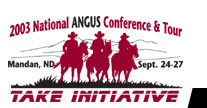 |
 |
|
 |
 |
|
|
 "Take the Time" Daryl Strohbehn, Iowa State University Click here to view the presentation (in PowerPoint format). Click here to listen to the presentation You will need Windows Media Player to listen in. Take time to prepare for future market trends Strohbehn pointed out that attendees had taken the first step in preparing for a successful future in the cattle industry by attending the conference. He advised them to use the conference and tour to hone their skills and improve their business strategy and savvy. "That’s what this is all about," he said, "being able to visit with your contemporaries and finding out what they’re doing that’s a little bit different, and how you might be able to steal something and take back to South Carolina or California or Arizona or wherever you might be."
"Today," Strohbehn said, "the consumer is becoming more of a powerful agent than they were in the past. They want to know. They want to know a lot." Global product expectation is getting higher, he continued. "Our world competition may dictate what we have to do in the future." Source and animal identity. Verifying of production processes. Quality assurance. Production supply chains. And Cattle care guidelines. "Those are the buzzwords you are going to be living by here in the next decade or so," he said. The case-ready revolution is here in a big way, Strohbehn told attendees. It’s forcing the packing industry to sell beef with zero trim, and that will affect grid and formula pricing. Branding peaked at almost 60 brands in June 2001, he shared, adding that the heat-and-eat products are being proliferated and are helping beef demand. "We’re going to see fewer cattle sold on a live basis and more of them going into grid markets," Strohbehn said. Strohbehn predicted the commercial sector would retain ownership more to capitalize on genetic and management investments, and commercial cattlemen would demand seedstock to position them correctly for the supply chain in terms of end product quality, cutability and weight. Supply chain access will require source and process verification, and market targets will be better defined. Database management and analysis will be necessary. Seedstock producers should prepare to be full-service providers, providing not only specification seedstock, but also feeder-cattle merchandising, assistance with retained-ownership programs, contract matings, embryo services, replacement heifer programs and seedstock alliances, Strohbehn said. "Most of all, you’re going to have to be information managers." Seedstock producers will have to have the same emphasis on profit traits as commercial producers, he continued. "We’re going to have to look at additional things in relationship to reproduction, health and efficiency." Due to the increased number of expected progeny differences (EPDs) and gene markers, the next step is to combine that information into selection and profit indexes to make it more understandable and usable for the commercial cattleman, Strohbehn said. "We’ve got to look at new approaches to using this information so we can get the job done, and get it done correctly." For more information about Strohbehn’s presentation, click on the links above to download an audio archive of his presentation or his PowerPoint presentation.
|
|
||||||||||